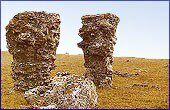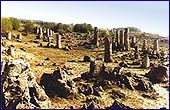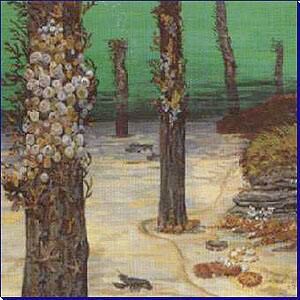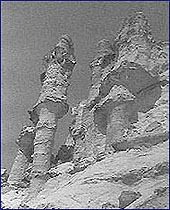 |
Stone
Forest is a fabulous natural pheno-mena most known with its Bulgarian
name of "Pobitite Kamani", which means "stones beaten into the ground",
a name completely corresponding to the reality. These are numerous
limestone pillars as high as 10 m, hollow or solid cylinders, truncated
cones, different bulgings and single rocks and cliffs.
Nowadays is believed that these carbonate - cemented sandstone structures were formed due to microbial methane oxidation around natural gas seepages - so called "bubbling" |
reefs".
The cementation occurred in the subbottom marine sands some 50 million
years ago and now are exposed by subsecuent erosion of the surrounding
unconsolidated sediments and vertical tectonic movements of the earth
crust.
| The
spectacular landscape of "Pobitite Kamani" is spotty spread in a North
- South orientated belt about 3 km wide and 8 km long. The stones
are clustered in seven large groups and several separate small areas
embracing a total area of more than 7 square kilometers. They are
localized running from south of Beloslav town, northward of lakeroad
and railway, around the Strashimirovo village and fertilizer plant
crossing the road E70 and highway finished around Slunchevo and Banovo
villages. The poles have been known as sacred place for centuries but are documented for the first time in 1829 and since then it have been of interest to many scientist. This unique place isannounced as national natural landmark in 1938 and now it is lobbing to be included in the UNESCO World List of Geological Forms. |
 |
The structures
of "Pobitite Kamani" consist of carbonate - cemented sand and silt deposits
of Lower Eocene age, the same sediments in which they occur. Except of
the exposed on the earth surface forms they are develop in another one
to three underground levels more (all four levels can be observed clearly
on the outcroppings in the "Karierata" site). The forms of any level usually
grow upon a solid limestone substratum most probably with the same origin.
 |
 |
 |
For centuries
the nature was shaping the stones, to turn them into awful sculptural
creation - animals, peoples, monsters, mythical creatures. "The Stone
Guardians", "The Camel", "The Throne", "The Stone Forest", "The Big Falos"
are the names of some of these natural phenomenon.
 |
 |
 |
 |
̉he
main, "Dikilitash" group is the most impressive and in a best state
of preservation. The place is easy reachable by the road E70 which
crosses it approximately 18 km west of Varna and is site of organizing
tourism. It comprises some 300 big and small pillars in a large strips
(about 850x120 m) and over 50 ones in a smaller spot southward. Some
of them are broken into two or three segments, other laid down, looking
as being excavated from their roots. The "Strashimirovo" group is
also very spectacular. It locates southward of the main group and
is composed of four rows from north to south. A characteristic feature
of the pillars here is that the middle part of any level is bulging,
like two communicating truncated cones. The circum stance of some
bulgings is over 9 m. The"Slunchevo" and "Banovo" groups located in
the vicinity of the corresponding village are charming too. A pillar
resembles a frozen fountain; another with base of 12 m in circumstance
is a rock lion; others are colossal awesome mushrooms. The "Karierata"
group includes several natural and manmade outcrops which are the
most instructive for development of these unique carbonate structures.
They attract attention of scientists from the beginning of the 1970s
when this area was an active sand-pit, abandoned now. All four levels
of the pillar development with a diversity of forms can be observed
here as well as limestone layers at their bases and all these in a
wall over 25 m high. Other groups are situated south of Beloslav town and also deserved to be seen, that's why I recommend to whom is already convince to visit this world unique place to reserve one whole day for the trip preparing for walking 15-20 km fn food and taking 30-40 snapshots et least. Several basic hypotheses about the genesis of the phenomenon have been developed ranging from designing of the structures by mechanical acting of the environmental factors (wind, rain, sea waves) |
to the precipitation of carbonate from percolating groundwaters (stalactite mode of formation) to coral complexes, algal bioconstructed build-ups (bioherms) and lithified forest. The answer of the origin was recently found in the Kattegat area of gas seepages, offshore Denmark where the modern submarine landscape "the bubbling reefs" is very similar to those of "Pobitite Kamani" (see two images et the end of the page).
|
|

Pobitite Kamani |

Bubbling Reefs |
However, the recently obtained scientific results suggest that carbonate formation in the area of "Pobitite Kamani" may have more complex origin and continues today by precipitation of carbonates from meteoric groundwater. These two images show very similar landscapes, are they?
The left one is a picture taken from the main, "Dikilitash" group of the "Pobitite Kamani" area, near Varna, Bulgaria and the second one is an art expression of the modern submarine landscape "the bubbling reefs" in the Kattegata rea of acvtive gas seepages offshore Denmark.
SELECTED REFERENCES
Nachev, I., P. Mandev, S. Zhelev, 1986. 'Pobitite Kamani' - algal bioherms. Rev. Bul. Geol. Soc., 47: 1-13. (in Bulgarian, English summary, with the most extensive bibliography).
Jansen, P., I. Aagaard, R. Burke Jr et al., 1992. "Bubbling reefs"; in the Kattegat: submarine landscapes of carbonate-cementad rocks support a diverse ecosystem at methane seeps. Mar. Ecology Progress Ser., 83: 103-102.
Botz, R., V. Georgiev, P. Stoffers et al., 1993. Stable isotope study of carbonate-cementad rocks from the Pobitite Kamani area, north-eastern Bulgaria. Geol. Rundsch., 82: 663-666.
Walter, H.,
1994. The stone forest near Varna, Bulgaria - Tertiary rock pillars of
unknown origin. Z. Angew. Geol., 40(1): 50-55.
for contacts geo@io-bas.bg
 genesys 1
genesys 1

